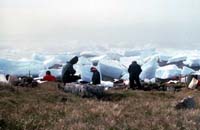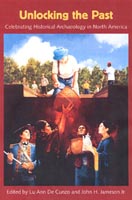Early Encounters with a "New" Land: Vikings and Englishmen in the North American Arctic
by William Fitzhugh

Smithsonian team excavates Inuit sites occupied at the time of the Frobisher voyages, under threat of surging ice.
Navigating without instruments, the Vikings traveled west across the North Atlantic. Sailing little more than two or three days at a time, they voyaged from land to land. As soon as they'd set up a colony on one land, they pressed on to other uninhabited lands further west. So it was that Eric the Red, banished from his home in Iceland, sailed west and discovered a land he named "Greenland" to attract settlers. Within a generation, he had established a thriving colony in arctic North America. Norse colonists raised sheep, goats, pigs, cows, and horses, like they had back home. Their livestock provided food, transportation, and raw materials for almost everything they needed, except iron and timber for building and fuel.
Although their history is full of mystery and adventure, the Vikings remain little known, misunderstood, and almost invisible on the American landscape. Few Americans took seriously the idea that Viking explorers had reached the North American mainland five hundred years before Columbus, and that they had a legitimate place in New World history. The finds at L'Anse aux Meadows and the many Norse artifacts and trade materials found in native Dorset and Inuit sites in northern Greenland and the Canadian Arctic have forced us to revise this history, and to give due credit to the Norse and other North European peoples who created and maintained a gateway between Europe and North America for most of the past thousand years.
Although these explorations of early European activities in arctic North America have produced as many new questions as answers, they provide new avenues into the past, amplifying and even changing our views of history as known from documentary sources alone. Today these and other sources of evidence have produced a new vision of early European contacts and exploration in a part of North America that produced little of political or economic interest to Europeans until the beginning of modern times. While these contacts never established permanent European settlements or enriched the coffers of Europe, they produced a wealth of geographical and scientific data. Equally important, these contacts familiarized America's northern native peoples with new materials, technologies and societies that would eventually transform their way of life as no other had before.
